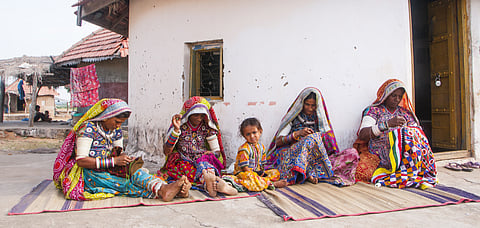
- Destinations
- Experiences
- Stay
- What's new
- Celebrating People
- Responsible Tourism
- CampaignsCampaigns
- SubscribeSubscribe
- Buy Now

The bus has left Bhuj and passed a board announcing the Tropic of Cancer. The sun is strong but the temperature outside is low and pleasant&ndashit&rsquos the tail end of winter after all. After a 15-minute drive, we pass a sign that says &lsquoShrujan LLDC&rsquo (that&rsquos short for Living and Learning Design Centre).
This rust-coloured complex houses what is perhaps India&rsquos biggest crafts museum, showcasing the embroidery work of 12 communities of Kutch. The museum has a gallery, a library and three craft studios. The gallery displays change from time to time, highlighting a variety of crafts, from textiles to pottery, metal, wood and stone.
Research and design students from colleges and schools, or anyone keen on embroidery, can sign up for a workshop here. A crafts school is also planned in the near future. It will have fully equipped working studios for all the crafts of Kutch.
The region may be known for the White Rann, droughts and the tragic earthquake of 2001, but&ndashwith a range of diverse but syncretic communities&ndashit is also one of the biggest hubs of crafts and textiles in the country.
Walk into the dimly lit (so that the textiles on display are not damaged by light) museum and you will see a jaw-dropping and humbling line-up of exquisite craftwork that is unlike anything you may have seen before. The museum displays a series of exhibits along with embroidered panels that are close-ups of the style, designs, motifs, etc. of each community in the region.
Their craft is more than just decoration for household goods it is an important means of personal, social and spiritual expression. The various embroidery styles are unique to each community. There is the dense and bold work by the Ahir community, animated with floral motifs, mirrors, peacocks and parrots the Jat-Garaasiya and Jat-Fakiraani of the Jats the Sodha-Pakko of the Sodhas the Soof and Khaarek of the Meghwad-Maarus and the Rabaari of the Rabaaris.
&ldquoEmbroidery is like an identity&ndashpeople know when they see a particular kind of embroidery that this person comes from that tribe,&rdquo says Ami Shroff, director of Shrujan. &ldquoBut this has been changing gradually. One, many people wear synthetics now. Second, the tribes have begun borrowing from each other so the distinct styles are getting mixed.&rdquo
Shrujan is a not-for-profit organisation working with craftswomen in Kutch to revitalise the ancient craft of hand embroidery. It was set up in 1969 by Ami&rsquos mother Chanda Shroff, a well-known crafts visionary, to sustain the work of Kutch&rsquos craftswomen.
&ldquoIt was my mother&rsquos idea to give the people who knew embroidery something better to work on than minimum-wage labour on roads or working on a construction site. They found this work familiar and could do it with far more dignity and grace.&rdquo
She talks about her mother&rsquos driving passion to find and conserve every possible variety of embroidery in the region and encourage people to revive the art. Chandaben, as she was fondly called, passed away last year after the Shrujan museum, created in collaboration with the LLDC, was launched.
It will take you quite a bit of time to walk through the museum, read the blurbs, watch the wall-mounted videos and photo displays, and scrutinise each embroidery panel. The whole thing is like a narrative of the communities&ndashembroidery being the medium.
And there are so many stories. Ami tells us about the Rabari community&rsquos ban against women embroidering, which happened around 1997. &ldquoIt was because the only dowry women would take with them was their trousseau that they embroidered themselves (and some vessels). And they couldn&rsquot enter their in-laws&rsquo house till they finished the trousseau. But they&rsquod have to embroider not just clothes, but torans for doors, a covering rug, something for the children they&rsquod have, and so on. It was much too time consuming. In some cases, women would get married but not move to their husband&rsquos place for many years. So the community elders decided enough was enough, and asked for a ban on the elaborate embroideries.&rdquo
The ban still exists apparently, though some enterprising women have found ways around it. But that&rsquos another story. Today, Shrujan Trust works with nearly 4,000 women across 100 villages in Kutch. Their work has featured at events like the Lakme Fashion Week, and graces the wardrobes of people across the world.
The LLDC complex is a must-visit&ndashas an artisanal destination, as an example of women&rsquos empowerment, and as a study in syncretism. The complex is a tranquil place, with mango and chikoo orchards. Most of the time you will see women at work, talking to each other while stitching away.
After you are done with the museum, you can take a break at the open canteen for local fare such as millet rotis or phulkas with the best ghee ever, poha or dhokla, Gujarati dal and delicious chaas.
The Information
Shrujan LLDC (shrujanlldc.org) is open every day except Mondays and public holidays timings 10am to 6pm photography (and videography) is prohibited in all the museum galleries.
Getting There
It is located in Ajrakhpur village, 15km from Bhuj on the Bhuj&mdashBhachau highway. State transport buses as well as private buses and shared auto-rickshaws are available from Bhuj to Ajrakhpur. Bhuj is connected by rail to Ahmedabad, Mumbai and Delhi, and by direct flights to Mumbai and Delhi.
